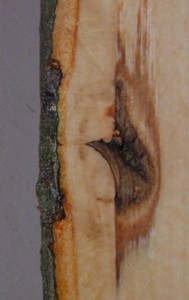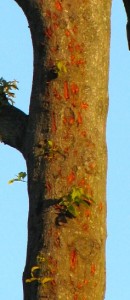
Decay Caused by a Single Wound from Climbing Spikes
Be careful who you hire to prune your valuable landscape trees. Unlike our neighbor Maryland, there are no state laws in Virginia protecting consumers from unqualified tree services. If a tree service allows its workers to wear sharp steel spikes while climbing your tree, inevitable permanent damage will follow. Unfortunately the majority of tree services in Hampton Roads allow their workers to climb trees using steel spikes. My advice is to avoid these companies and hire a tree service that employs ISA Certified Arborists and follows ANSI A300 Pruning Standards.
Damage Caused by Climbing Spikes
When a climber wears spikes, every step taken will pierce tree bark and puncture vital tree tissue inside. Sap will often ooze from these wounds and leave ugly streaks of discolored bark. The damage is worse than you might initially think. What you don’t see on the outside is the internal damage to the cambium and the tissue death that surrounds the injury. As the climber moves around the tree, the damage continues to accumulate, step after damaging step. A single pruning can cause hundreds of injuries to your tree that will never heal. Trees don’t have the ability to heal, they can only seal off the injured tissue. The damage is irreversible.
These wounds often lead to further problems. Climbing spikes can carry infectious diseases from use on a previous dead tree and spread harmful pathogens to your healthy tree. Open wounds will allow the entry of decay-causing fungi and wood-boring beetles. Many wood-boring beetles are attracted to these wounds from chemical signals released by the oozing sap. Overall vitality of your tree will be reduced, stored energy will be lost and your tree will have to expend valuable resources compartmentalizing dozens, perhaps hundreds of wounds. Canker causing pathogens can damage the bark permanently and disfigure or kill your tree.

Irreversible Wounds from Climbing Spikes
Educated and responsible arborists have known these facts for a long time. Over a hundred years ago a New York state annual report declared,
As trees grow larger and older they require pruning occasionally to improve their shape, to remove dead limbs, and, in the case of very old trees, to restore them to vigor. This work should not be entrusted to ignorant, inexperienced men, as is too often the case. Men of this class frequent our cities and solicit employment as tree pruners. With glib tongues they describe defects, real or otherwise, in street or lawn trees, and obtain permission to do some work. As a result beautiful specimens have been disfigured or irremediably injured in many of our cities.
Pruning Without Climbing Spikes
Skilled tree climbers use alternate means to ascend and climb your trees. We typically use ropes and harnesses combined with modern climbing techniques to prune your trees responsibly.
Climbing spikes can be used during tree removals but they should not be used during normal tree care practices. When you hire Streamline Tree Care, you can be sure our arborists will comply with industry standards. It’s important that climbers are educated both in proper pruning and climbing techniques. Our climbers undergo formal training to ensure that your trees are cared for properly.
